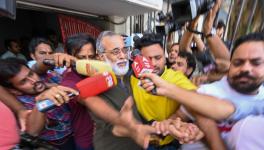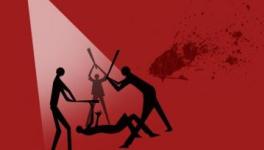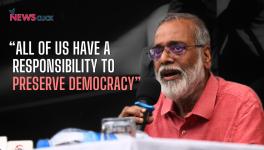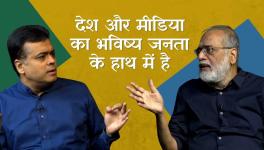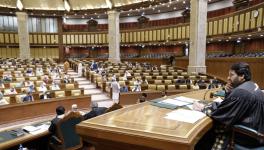Press Freedom Under Attack, 6 Journalists Killed in 2021: Report
NEW DELHI: Press freedom in India has been under attack with at least six journalists being killed, many more physically assaulted, and media houses being targeted, showed the India Press Freedom Report 2021.
Released by think tank Rights and Risks Analysis Group (RRAG) on Wednesday, the report documented targetting of 108 journalists and 13 media houses/newspapers even though a pandemic raged on in the country.
Of those killed, Uttar Pradesh and Bihar reported two deaths each, while Andhra Pradesh and Maharashtra reported one death each. At least four of the six were killed allegedly for their journalistic work. While one journalist had sought police protection from the liquor mafia a day before he was found dead, another was killed when covering the farmers' protest.
This report gains significance with India ranking 142 in the 2021 World Press Freedom Index published by media watchdog Reporters Without Borders (RSF).
Among states and UTs, Jammu and Kashmir topped the list with 25 journalists and media houses being targeted, followed by Uttar Pradesh, where 23 such incidents occurred. Madhya Pradesh, Tripura, and Delhi were among the top five places where both journalists and media organisations faced harassment.
Bihar saw at least six such attacks, Assam five, Haryana and Maharashtra saw four each, Goa and Manipur witnessed three each, followed by Karnataka, Tamil Nadu and West Bengal with two incidents each.
Physical assault remained the primary way to clamp down on journalists in 2021, with at least 24 journalists attacked, said the report. The highest number of such cases was reported from Jammu and Kashmir.
At least eight women journalists faced arrest, sexual harassment or were summoned in 2021, the report's analysis said. Muslim women journalists were also targeted online. However, the State's response to this remained inadequate.
When it came to invoking sections against journalists and media houses, states used IPC Section 124A -- sedition, Section 153 – wantonly giving provocation with intent to cause a riot, Section 153A -- promoting enmity between religious groups, Section 153B -- imputations, assertions prejudicial to national integration, defamation, the draconian Unlawful Atrocities (Prevention) Act (UAPA), the Information and Technology Act including Section 66A and Section 66F, the Epidemic Diseases Act, 1897, the report said.
"The key concern is reporting has been made into a criminal offence. That criminal offence is quite serious relating to sedition and UAPA... This will lead to some form of self-censorship because journalists do not want to be prosecuted for performing their duties. This has a significant impact on the way people report and the suppression of truth. The report documents the scale of the attack on journalists," Suhas Chakma, director of RRAG, told NewsClick.
He observed that the Centre's Information Technology (Intermediary Guidelines and Digital Media Ethics Code) Rules 2021 was another blow to media freedom.
Rampant Arrests, Detentions, FIRs Remain
Jammu and Kashmir reported the highest number of arrests and detentions, with at least five journalists being targeted by State actors, followed by Delhi. While Maharashtra, Manipur and Tripura saw two such instances each, Assam, Chhattisgarh and Haryana saw one such case each.
Human rights defender and veteran journalist John Dayal told NewsClick that the present state of affairs was an 'undeclared Emergency'.
"Independent media remains small, fragile and under constant threat of arrest, financial blocking, or physical violence. In regions such as Kashmir, the Northeast, arrests of reporters, the control of the internet, and the presence of the military add to the physical and mental stress on the media (sic)," said Dayal.
The United Nations Special Rapporteur and the Editors Guild of India had expressed concern over the dwindling press freedom and journalists' rights in Jammu and Kashmir. Wednesday's report substantiates the concerns flagging that denial of media freedom seemed to be the norm in the Valley, with journalists being arbitrarily summoned to police stations, named in FIRs and being roughed up by security forces.
The situation in the rest of India also seemed dismal, with the lodging of FIRs against journalists and media houses remaining a tool to muzzle press freedom. At least 44 journalists and two media organisations faced such actions across the country. Multiple FIRs were lodged against journalists in several instances, including against Rajdeep Sardesai, Mrinal Pande, Zafar Agha, Paresh Nath, Vinod K Jose, and Anant Nath, in different states.
The Bharatiya Janata Party-ruled Uttar Pradesh saw the highest number of FIRs against journalists with nine such instances, followed by Delhi, and Jammu and Kashmir.
The systemic attack against the media also included the Enforcement Directorate (ED) and Income Tax (IT) raiding offices of media publications and houses of journalists who were critical of the Centre's policies; such media houses include NewsClick, Dainik Bhaskar and Bharat Samachar, and Newslaundry.
Kavita Krishnan, secretary of the All India Progressive Women's Association, told NewsClick that the Narendra Modi government's record in jailing, surveilling, and threatening journalists in the Valley and the rest of India was 'unsurpassed'.
"The New York Times' revelations have shown that the Modi government acquired the Pegasus software secretly using public funds and then deployed it to spy on journalists who are doing their job of scrutinising the government's actions, as well as on sitting judges, Opposition politicians, and activists. This is the worst blow to press freedom and democracy in India's history," Krishnan claimed. "We cannot forget the assassination of journalist Gauri Lankesh by Hindu supremacists who enjoy the patronage of the regime," she added.
Following the Pegasus revelations, the Supreme Court had constituted a committee to investigate the alleged use of the spyware on Indians. Recently, the Editor's Guild of India also wrote to the panel to inquire into the claims.
Unabated Online Trolling
As journalists grappled with detentions, arrests, FIRs and summons, they also faced attacks from non-state actors, including political party activists, mafia and online trolls last year. At least 34 journalists and media houses were attacked by mobs, unidentified miscreants, members or supporters of political parties or harassed online.
Earlier, the RSF report pointed out that coordinated hate campaigns were waged on social networks against journalists who criticised the Modi government.
"Ever since the general elections in the spring of 2019, won overwhelmingly by Prime Minister Narendra Modi's Bharatiya Janata Party, pressure has increased on the media to toe the Hindu nationalist government's line. Indians who espouse Hindutva, the ideology that gave rise to radical right-wing Hindu nationalism, are trying to purge all manifestations of "anti-national" thought from the public debate... The campaigns are particularly violent when the targets are women," it said.
Get the latest reports & analysis with people's perspective on Protests, movements & deep analytical videos, discussions of the current affairs in your Telegram app. Subscribe to NewsClick's Telegram channel & get Real-Time updates on stories, as they get published on our website.











